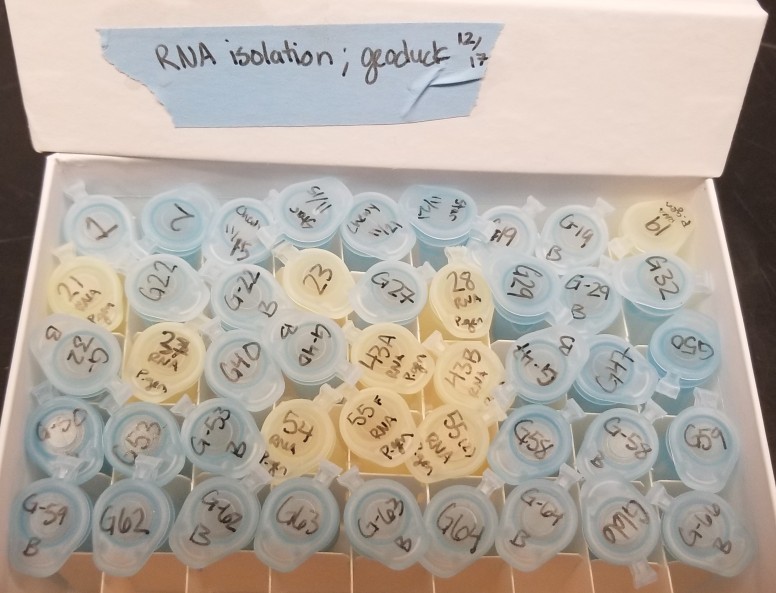Recap
The overall goal is to identify whether the geoduck are reproductively developed (ready to spawn), and potentially whether the geoduck are male or female, using hemolymph (which can be non-lethally collected).
So far we have…
1.Identified biomarkers for reproductive development/sex
- Developed primers for biomarkers
Next Steps:
I want to test the newly developed primers, but first I need to ensure I have adequate amounts of RNA and cDNA because I now have 17 primer pairs to test.
- want to include more males/females across more reproductive stages
- went through leftover hemolymph samples from known individuals
Identified 9 female and 7 male hemolymph samples across stages for qPCR:
| Sample | Sex | Stage |
| 19 | F | 2 |
| 21 | F | 2 |
| 23 | F | 2 |
| 55 | F | 3 |
| 31 | F | 4 |
| 39 | F | 5 |
| 37 | F | 6 |
| 57 | F | 7 |
| 61 | F | 7 |
| 28 | M | 1 |
| 27 | M | 2 |
| 54 | M | 3 |
| 43 | M | 4 |
| 59 | M | 4 |
| 62 | M | 5 |
| 66 | M | 5 |
Samples for RNA extraction:
50ng RNA is needed for the RT protocol (100 ng is ideal esp. since I will use 1ul of template) so previous samples will need to be extracted again: 19, 21, 23, 55, 37, 28, 54, and 43.
Samples for RT (to make cDNA):
Samples that did not amplify previously may have had errors during RT so I will remake their RT in addition to the new samples: 19, 21, 23, 55, 37, 28, 54, 43, 39, 57, 62, and 66.
RNA Isolation:
RNA was isolated with a Quick-DNA/RNA Microprep Plus Kit by ZymoResearch according to the manufacturer’s protocol from geoduck hemolymph samples. 300ul of sample was used and 1200ul of lysis buffer was added for sample prep. All 250ul of sample 19 was used and 1000ul of lysis buffer added instead. The RNA was NOT DNased (will need to be done before RT).
I tested the ‘whole blood’ manufacturer instructions on sample 43B; sample 43A was done normally. Sample 54 was accidentally added to the sample 55 column. I pipetted out the supernatent from the 55 column, denoted the column as 55F, and added the supernatent to the correct 54 column. Then I got a new column for the second half of 55, labelled it as 55(2) and continued the extraction.
Samples were quantified with the hsRNA Assay for Qubit according to manufacturer’s protocol. 2ul of sample and 198ul of working solution was used per assay tube. Standard 1: 92.49 RFU and Standard 2: 1881.11 RFU.
| Sample | Sex | Stage | RNA (ng/ul) |
| 19 | F | 2 | 35.8 |
| 21 | F | 2 | 18 |
| 23 | F | 2 | low (151.89 RFU) |
| 28 | M | 1 | 18.7 |
| 37 | F | 6 | high (4893.75 RFU) |
| 43A | M | 4 | high (3520.34 RFU) |
| 43B | M | 3 | 3.62 |
| 54 | F | 3 | high (3152.78 RFU) |
| 55F | F | 7 | high (3544.7 RFU) |
| 55(2) | M | 4 | 57 |
Although in RFU range, the low sample may be under ng/ul minimum and is likely not enough for RT. High samples will need to be diluted 1:2 and be requantified.
Samples are stored in a box in the -80C freezer in 3, 3, 2, labelled “RNA isolations; geoduck 12/17”. Note that blue tubes are from previous RNA isolations which were DNased, and those with ‘B’ denoted are from the second round of RNA extractions (contain 0ng RNA). The samples extracted today, which are not DNased, are in yellow tubes.
How much cDNA should I make?
- RT protocol provides 20ul of template
- will use 1ul of template for qPCR
- = total of 20 samples that can be done
- run samples in duplicate…
- must do 2 rounds of RT to get enough cDNA for 1 round of qPCR with 17 primers
- run samples in duplicate…
- = total of 20 samples that can be done
- will use 1ul of template for qPCR
- RT calculations
I also picked up the new primers from Biochem stores which are on the benchtop in 209.

